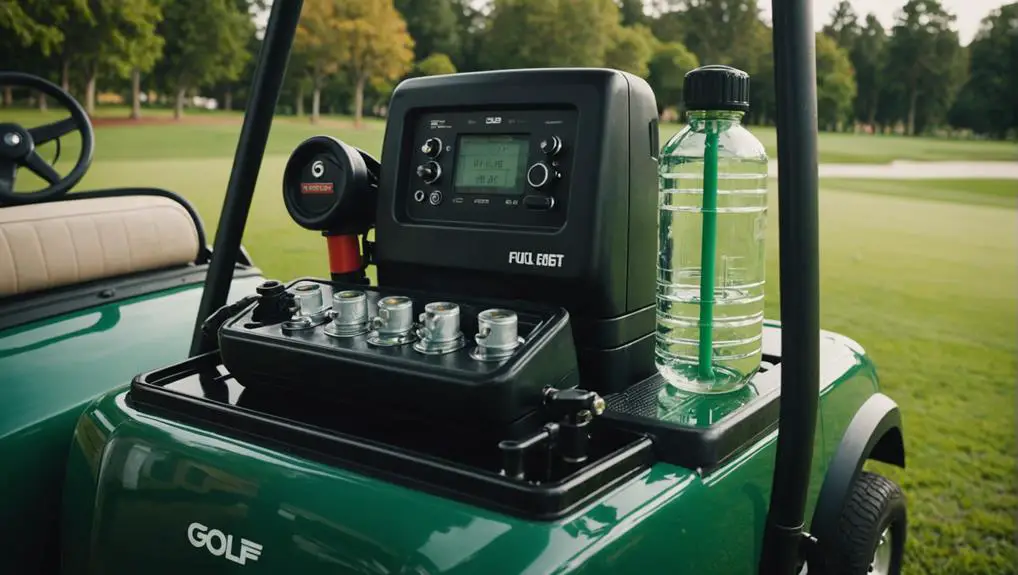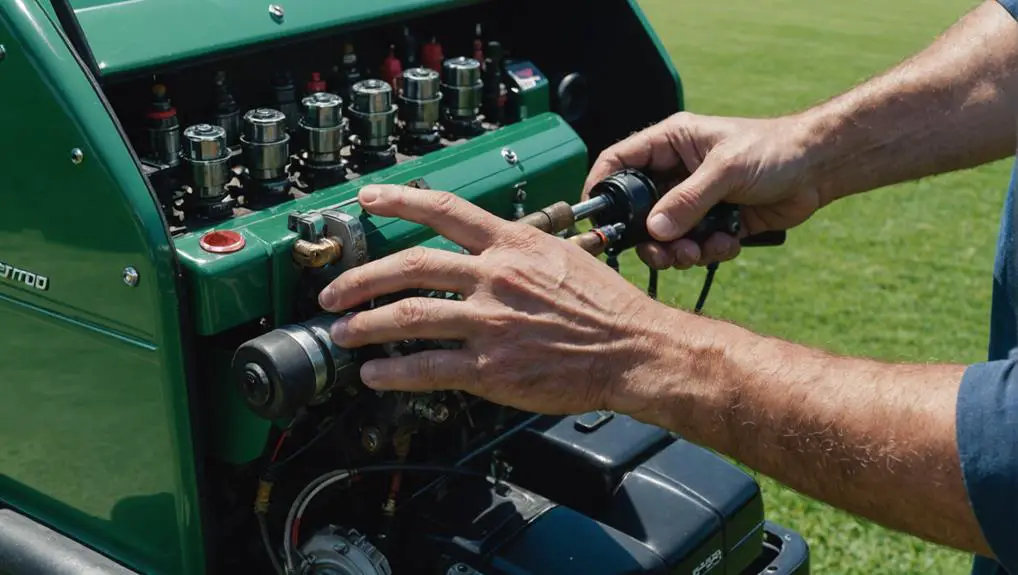When your EZGO golf cart won't start, it can be frustrating, but you can troubleshoot the issue systematically. Start by checking the battery for any signs of corrosion or loose connections, as these are common culprits. Next, you'll want to verify the battery voltage and inspect the ignition system. Each step can reveal clues about what's preventing your cart from starting. However, there are more aspects to contemplate that might surprise you, especially when it comes to the wiring and the starter motor. What could be lurking beneath the surface?
Key Takeaways
- Ensure the battery is fully charged and terminals are clean and secure, checking for corrosion or loose connections.
- Verify the ignition switch is fully engaged and inspect the ignition coil for continuity; replace if necessary.
- Check the fuel level and inspect fuel lines and filter for clogs or leaks; ensure the fuel pump is operational.
- Examine wiring connections for tightness and damage, focusing on battery cables, harnesses, and ground connections.
- Test the starter motor for proper voltage and functionality; replace if it shows signs of wear or fails to operate.
Check the Battery Status
When troubleshooting your EZGO golf cart, the first step is to check the battery status. Start by ensuring the key is off, then open the battery compartment.
Inspect the battery terminals for corrosion or loose connections. If you notice any buildup, clean it with a mixture of baking soda and water, and tighten the connections securely.
Next, check the battery voltage using a multimeter. Set the multimeter to the DC voltage setting, and connect the red probe to the positive terminal and the black probe to the negative terminal. A fully charged battery should read between 12.4 and 12.7 volts.
If it reads below 12 volts, you'll likely need to recharge or replace the battery.
Additionally, examine the battery age; most lead-acid batteries last about four to six years. If your battery is older, consider replacing it to avoid ongoing issues.
Inspect the Ignition System
After verifying your battery is in good condition, the next step involves inspecting the ignition system.
Start by checking the ignition switch. Verify it's fully engaged; a loose connection can prevent the cart from starting. If the switch feels faulty, consider replacing it.
Next, examine the ignition coil. Use a multimeter to test for continuity. If there's no continuity, you'll need to replace the coil.
Check the spark plug as well; a worn or fouled spark plug can hinder ignition. Remove it and inspect for damage or carbon buildup. Clean or replace it as necessary.
Inspect the wiring harness connected to the ignition components. Look for frayed wires, corrosion, or loose connections that could disrupt the electrical flow.
If you find any issues, repair or replace those components accordingly.
Examine the Fuel System

To guarantee your EZGO golf cart functions properly, it's vital to examine the fuel system. A malfunctioning fuel system can prevent your cart from starting, so follow these steps to troubleshoot effectively.
- Check the Fuel Level: Verify you have enough fuel in the tank. Sometimes, it's as simple as running out of gas.
- Inspect Fuel Lines: Examine the fuel lines for any signs of wear, cracks, or leaks. Damaged lines can hinder fuel flow. If you notice any issues, replace the affected sections.
- Evaluate the Fuel Filter: A clogged fuel filter can restrict fuel flow to the engine. Remove the filter and check for blockages. If it's dirty or plugged, replace it with a new one.
After completing these checks, if your cart still won't start, it may be time to explore deeper into other components.
Review the Wiring Connections
How can faulty wiring connections impact your EZGO golf cart's performance? Poor connections can lead to insufficient power reaching critical components, resulting in a no-start condition.
Start by inspecting the battery cables. Confirm they're tight and free from corrosion. Corroded or loose connections can greatly affect voltage delivery.
Next, check the wiring harness for any visible damage. Look for frayed wires, burnt insulation, or signs of wear. If you find any issues, repair or replace the affected wiring immediately.
Pay attention to connectors; loose or dirty connections can interrupt the flow of electricity. Clean any dirty terminals and secure them firmly.
Examine the ground connections as well. A weak ground can create erratic behavior in your golf cart. Make sure ground wires are securely attached to both the battery and the cart frame, free of rust or dirt.
Lastly, trace the wiring from the battery to the ignition switch and other components. Look for any signs of wear or damage that could disrupt functionality.
Test the Starter Motor

Once you've verified the wiring connections are secure, it's time to test the starter motor. This component is essential for starting your EZGO golf cart, so you'll need to guarantee it's functioning correctly.
Start by following these steps:
- Check Voltage: Use a multimeter to measure the voltage at the starter motor terminals. You should see a reading close to the battery voltage. If it's considerably lower, your starter motor might be failing.
- Inspect for Damage: Look for any visible signs of wear or damage on the starter motor. Cracks, corrosion, or burnt wires indicate that it may need replacement.
- Perform a Bench Test: If you're still uncertain, remove the starter motor and perform a bench test. Connect it directly to a power source to see if it spins. If it doesn't, it's likely defective.
Frequently Asked Questions
What Tools Do I Need for Troubleshooting My Golf Cart?
To troubleshoot your golf cart effectively, you'll need a few essential tools.
Grab a multimeter to check voltage and continuity, a socket set for removing bolts, and a screwdriver set for accessing various components.
Don't forget a wrench set for tightening and loosening connections.
Having a diagnostic tool can also help identify electronic issues.
Keeping these tools handy will streamline your troubleshooting process and help you diagnose problems efficiently.
How Often Should I Perform Maintenance on My EZGO Golf Cart?
You should perform maintenance on your EZGO golf cart at least once a year, but more frequent checks are recommended if you use it regularly.
Keep an eye on the batteries, brakes, tires, and electrical systems; they need regular inspections.
Cleaning your cart and checking fluid levels every few months will also help maintain peak performance.
Following the manufacturer's guidelines guarantees longevity and reliability, so don't overlook routine maintenance tasks.
Can Weather Conditions Affect My Golf Cart's Performance?
Weather conditions can dramatically influence your golf cart's performance, like a painter altering a canvas with different colors.
Extreme heat can drain battery life, while cold temperatures can reduce power and efficiency.
Rain and humidity may lead to electrical issues, causing malfunctions.
To maintain peak performance, store your cart in a controlled environment, and check connections and batteries regularly.
Adapting to weather changes helps guarantee a reliable ride on the course.
What Are Common Signs of a Failing Golf Cart Battery?
When a golf cart battery's failing, you'll notice several key signs.
First, the cart struggles to start or doesn't respond at all. You may also see a significant drop in speed or power during operation.
If the battery's charging time increases or it loses charge quickly, that's another red flag.
Is It Safe to Jump-Start an EZGO Golf Cart?
Jump-starting an EZGO golf cart can be safe if you follow proper procedures. Confirm the batteries are similar in voltage to avoid damage.
Connect the positive terminals first, then the negative, and always wear safety gear. Avoid jump-starting if the cart shows signs of a failing battery or electrical issues, as it could cause further problems.
Regular maintenance and checking connections can prevent the need for jump-starting in the first place.
Conclusion
Successfully solving your EZGO golf cart's starting struggles involves systematic scrutiny. Start with the battery's condition, then swiftly shift to the ignition and fuel systems. Staying sharp, review wiring connections and test the starter motor. With a methodical mindset, you can master the mechanics and guarantee your cart runs reliably. Remember, a little diligence goes a long way in delivering dependable driving experiences. Don't delay—dive into these diagnostics today!